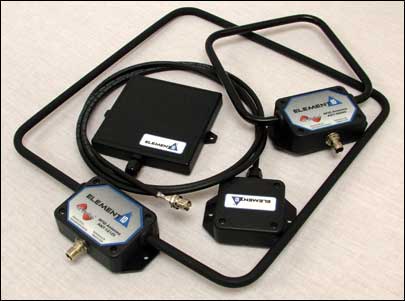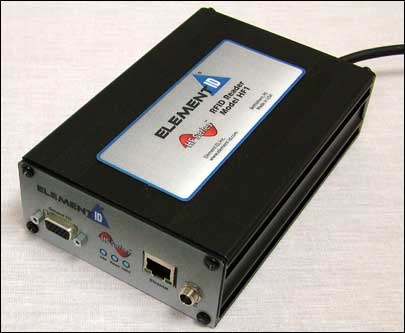Element ID, a startup firm based in Bethlehem, Pa., is leveraging its founders’ roots in industrial automation to deliver RFID equipment optimized to work in manufacturing, production and assembly lines, sorting facilities, and warehouses.
The company, founded in 2006, has unveiled its first products: two high-frequency (HF) interrogators designed for such automated applications as manufacturing and work-in-process monitoring, tracking of totes or product carriers, and replacement of fixed depth-of-field bar-code line scanners. Both readers—the HF1 and HF1-B (the more basic of the two)—operate at 13.56 MHz, support the ISO 15693 standard, and have a read range of 8 inches. Central to the new products’ functionality are software components embedded in the readers, enabling them to quickly share data with a variety of legacy and newer automation systems that companies currently use, for instance, to control their production lines or sorting systems.
In an industrial automation environment, says Jack Romaine, Element ID’s CEO, tag data read by RFID interrogators typically needs to take two paths. The information needs to be delivered very precisely, via a real-time interface, to PLCs, sortation controllers, or other devices that help route boxes to an end location. The data also needs to be delivered to back-end systems, such as enterprise resource planning (ERP) or warehouse management systems, to help companies track, for example, inventory. Most RFID technology vendors have focused on the latter, Romaine says, leveraging readers and middleware that can then filter and deliver RFID data to back-end systems.
“The piece that was missing was that real-time connection to automation systems,” Romaine explains, adding that the HF1 and HF1-B models “are designed to eliminate any bottlenecks.” The new readers, he says have been tested in Element ID’s labs, at conveyor speeds in excess of 600 feet per minute.
The two software components that enable the real-time connection to automation systems include Element ID’s HyperSage technology, designed to accelerate read rates and pre-process data to deliver only the information required, in the desired format, to the appropriate automation systems operating on the floor. The other component, TagLink (for which Element ID has a patent pending), provides algorithms and calculations that, when combined with RFID tag reads, enable it to deliver instructions to sorting and other automation systems at precisely the proper moment, so that companies can track and sort containers, packages and other objects as they move down a conveyor.For example, a tagged container passes an RFID interrogator, which reads the tag’s unique ID number, checks shipping instructions or other back-end data regarding that container and determines that the tagged item needs to be diverted to another conveyor beginning farther down the line. The reader prepares a message to the sorting system that handles that diversion, but needs to send that message at the precise moment the tagged item reaches that particular sorting system. TagLink tracks the item, taking into account what is happening with all of the various automation systems, in order to ensure the message is delivered at the proper time. TagLink, for instance, will recalculate the message delivery time if a conveyor system halts or slows for any reason, thus affecting when the tagged item reaches the diversion point.
Element ID’s software components are embedded in the readers, which Romaine says have “a lot of processing horsepower and are really designed specifically for automation. The readers have high-performance processors and the highly optimized software.” In addition, he notes, the interrogators contain built-in application interfaces that work with approximately 80 percent of the various automation systems currently in existence, thus eliminating the need for custom software coding. The readers have a built-in Web browser interface, and by securely logging into a host computer and typing in an interrogator’s IP address, a user can fully configure the system via a drop-down menu.
The readers operate with external antennas—standard antenna sizes include 2.5 inches (ANT-2.5), 4.5 inches (ANT-4.5), 6 inches (ANT-0606S) and 12 inches under-conveyor (ANT-1205R)—with custom antennas also available. In addition, the interrogators feature LED diagnostics for quick, at-a-glance performance analysis and a rugged, industrial construction with a sealed enclosure to minimize dust intrusion.
Pricing varies depending on antenna configurations, but the HF-1 starts at $3,250. The HF-1B, which lacks the TagLink software and a few other features, starts at $2,000. The readers, now in production, are expected to become available by late May 2009.



